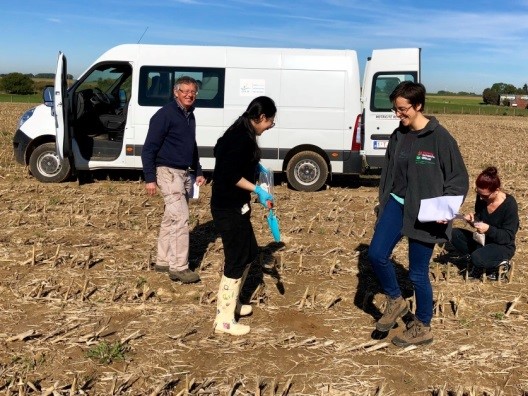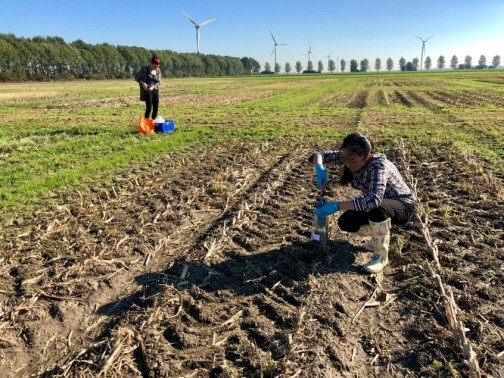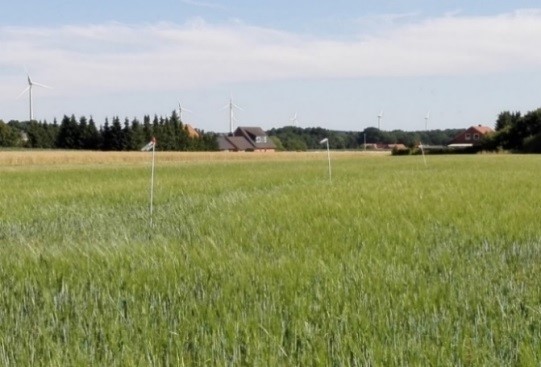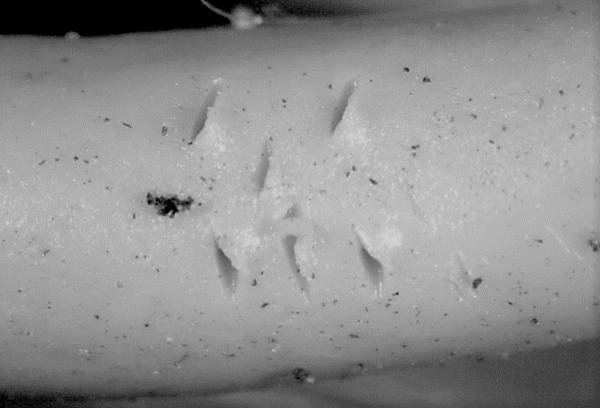Crop diversification and soil biodiversity (Thünen Institut).
Soil microbial activities improve soil structure and support plant growth. Diversified cropping systems with reduced fertilizer inputs should stabilize these beneficial functions by increasing the structural and functional diversity of soil microbial communities, but experimental evidence is still scarce.
In DiverIMPACTS, soil microbial communities in current and alternative cropping systems are assessed in field experiments using high-throughput sequencing of soil DNA and new bioinformatic tools. The rhizosphere is the soil compartment affected by plant roots and is densely colonized by soil microorganisms, including Bacteria, Archaea and Fungi. These organisms utilize energy-rich carbon sources provided by plant roots and in turn may increase soil nitrogen levels, improve the availability of phosphate and iron to the plant, and supress soil-borne microbial pathogens, thereby improving plant yield and health. The carbon sources released by plant roots vary between different crops, and thus enrich structured microbial communities differently. Crop diversification should, therefore, result in a higher overall microbial diversity. Ecological theory states that the stability of ecosystems correlates with biological diversity, and thus we hypothesize that crop diversification stabilizes microbiologically mediated ecosystem functions.
In DiverIMPACTS three experimental field sites (field experiment 2 in Germany, field experiment 3 in Belgium and field experiment 7 in the Netherlands) were selected to investigate the effects of diversification on microbial diversity and function. Soil sampling was performed in September and further samples will be collected before and after the growing season in 2019 and 2020. The microbial communities will be characterized by molecular analyses of soil DNA. Using quantitative Polymerase Chain Reaction, the population sizes of Bacteria, Archaea and Fungi will be quantified. The same method will be used to assess the abundance of functional genes related to nitrogen transformations, including nitrification, denitrification and nitrogen fixation. In order to reveal the diversity and identity of microorganisms providing these functions and their response to different diversification and soil management practices, a subset of the soil samples will also be subjected to DNA-sequencing and bioinformatic analyses. This will allow us to quantify the beneficial effects of cropping systems on soil fertility and health.
Crop diversification and biocontrol (Thünen Institut)
Spatial and temporal diversification of cropping systems can affect the abundance and diversity of epigaeic arthropods (biocontrol agents), increasing the potential and resilience of biocontrol within the crops. In DiverIMPACTS, we will test these hypotheses by collecting samples from selected established long-term field experiments and newly developed innovative experiments. In addition, we will work on the commercial fields involved in the Lower Saxony Chamber of Agriculture’s case study in Germany.
Invertebrate predation, seed predation and habitat provision for epigaeic arthropods are the main ecosystem functions that will be investigated in our research. A set of standard common field methods (Rapid Ecosystem Function Assessment) will be used to assess the abovementioned ecosystem functions in the field experiments, comparing diversified and non-diversified cropping systems. For each selected experiment, we will set up specific protocols based on the features of the experimental sites (e.g., experimental design, plot size, time plan). The proposed Rapid Ecosystem Function Assessment methods enable standardized and comparable measurements of the ecosystem functions within and across the sites.
The results from each field experiment will be analysed individually, and a comparison of effects across experiments will be performed via meta-analysis. The first samples have already been collected in field experiment 8 in Switzerland (June and September 2018) and in case study 3 in Germany (July 2018). This series of measurements provided the first responses about feasibility and quality of the methods tested. Starting from spring 2019 we plan to implement these measurements in more field experiments within the DiverIMPACTS network.
Further information
Authors
Bei Liu, Thünen Institute of Biodiversity, Germany
Christoph C. Tebbe, Thünen Institute of Biodiversity, Germany
Giovanni Antonio Puliga, Thünen Institute of Biodiversity, Germany








 tap and then scroll down to the Add to Home Screen command.
tap and then scroll down to the Add to Home Screen command.